The reasons why the hybrid cloud strategy is driving the trend are not a secret anymore. The biggest and most important reason of all is that it enables cloud service customers to leverage the benefits of both public and private cloud deployments depending on the need for speed of execution, availability of resources, and data protection & security. They can leverage leading-edge functionality at low cost and at the same time securing sensitive applications and data.
Hybrid Cloud deployment approach
Hybrid cloud deployment involves using multiple cloud services across different deployment models – in particular, it combines the use of public cloud as well as private cloud services. With this basic definition, there can be multiple combinations of cloud service/resources possible for deployment based on the requirement of the end application. Even the mix of different models of cloud services such as SaaS, PaaS and IaaS can be a combination for a hybrid deployment.
For example, an on-premises private SaaS cloud service could be combined with a publicly hosted PaaS cloud service for a hybrid deployment. Even the private cloud can be hosted off premises or alternately on-premises in a dedicated part of the data center.
Most enterprises have cloud resources connected to a significant on-premises IT system as not all of them are necessarily “born on cloud”. The common hybrid cloud architecture for such organizations is to combine on-premises cloud resources with off-premises cloud resources to enable the business with a wide range of capabilities.
What value does hybrid cloud deployment bring to the business?
While IT businesses operate at multiple speeds and require being innovative and agile to stay ahead in the competition, the established processes and systems evolve with time at a slower pace and cannot be replaced instantaneously.
On one side, stable speed is required for implementing IT services in a large scale , and on the other side, fast evolution helps with new growth opportunities. Hybrid cloud deployment is capable to deliver the best of both sides. There are three key areas of business where hybrid cloud could add exceptional value:
1. Fast, elastic and highly cost-efficient – aligned to support two speed IT
Hybrid cloud deployment can control all types of cloud services with orchestration, interconnection, and vigorous utilization. It supports elastic and rapidly responsive IT that quickly addresses the demands of the fast speed of engagement (SoE) and steady speed of record (SoR). Composable infrastructure services and open infrastructure APIs enable programmable IT and automation driven workloads.
2. Enables flexibility in terms of build and deployment – leveraging best capabilities of cloud services
With a hybrid deployment, businesses are no longer restricted to use what is available on-premises. And it also makes it easier to implement security and in terms of encryption, automation, orchestration and endpoint security measures to manage the risks effectively. The entire catalogue of the services provides flexibility while defining build and deployment strategies.
3. Innovating faster while accessing the same systems and capabilities
Hybrid cloud deployment enables enterprises to improve their time to market by enhancing overall IT performance and delivering agility to address changing business requirements. The power to evolve with changes and responding to the change quickly help with to sustain the competition and innovate faster.
How to Build a Hybrid Cloud Environment
Every cloud deployment is different depending on the business need because private clouds are one-of-its-kind, but public clouds are many. Hence, there isn’t any one-size-fits-all solution. How a business builds its cloud infrastructure is as unique as a thumbprint. Although, there are two basic ways of constructing a hybrid cloud solution.
Conventional Hybrid Cloud Architecture
Conventional hybrid cloud deployment is when a private cloud environment is connected to the public cloud using massive iterations of middleware in a complex manner. All you need is to link a prepackaged private cloud resources with a public cloud infrastructure. As many cloud service providers have preconfigured VPN in their infrastructure subscription package, moving and streamlining resources between the two environments becomes easy. But it still requires a powerful middleware.
Modern Hybrid Cloud Architecture
Enterprises prefer to have the portability of applications to run within the cloud infrastructure rather than connecting two different environments. Therefore, they tend to build their customized hybrid cloud environment and deploy applications independently as loosely coupled, and small services.
With a uniform platform running under the same operating system in each environment, the universality of the applications can be extended to the underlying environments. The same OS extracts all the hardware requirements while orchestration extracts all the application requirements. This helps you create an interrelated cloud ecosystem in which movement of applications without using APIs is possible and it is changeable with any upgrade.
Use cases of Hybrid Cloud deployment
1. Disaster Recovery Plan
For data backup during equipment/site failure, high durability, accessibility, fast recovery (RTO) and timely snapshot (RPO) are critical aspects. Hybrid cloud deployment is the cost-efficient solution as a disaster recovery plan. Data backup can be replicated at low cost public cloud while on-premises infrastructure can be leveraged as local storage for faster access.
| On-premises infrastructure | Local storage for backup data |
| Public cloud | Copy of backup data |
| Policy-based replication of data management | |
2. Adaptable Capacity Management:
If migration of excess capacity is possible effortlessly to the public cloud while freeing up on-premises storage, the burden of capacity planning eases down. Hybrid cloud deployment can make use of integrated tools to transparently migrate intermittently used data.
| On-premises infrastructure | Local storage for recent or frequently used data |
| Public cloud | Archive older or less frequently used data |
| Policy-based replication of data management | |
Bottom Line
Some degree of management, workload orchestration and portability across multiple environments are fundamental characteristics of a hybrid cloud deployment. While the architecture of a Hybrid cloud can vary a lot, it is more helpful when defined based on the need. With this taken care of, the resulted solution will be responsive, elastic and adaptable to changing business need.
If you are planning to migrate or deploy any of the Public, Private and Hybrid cloud environment, contact our team today.














